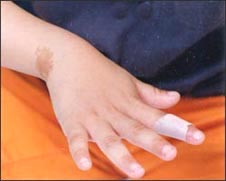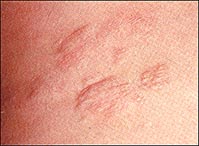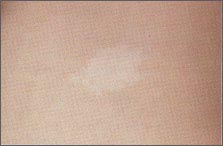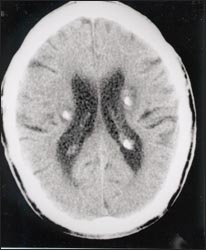피부 신경 증후군, Neurocutaneous syndrome
피부 신경 증후군의 개요
- 피부, 손톱, 모발, 눈, 입, 귀 등의 기관, 조직과 중추 신경계는 발생학적으로 외배엽에서 발생 분화된다.
- 외배엽에서 발생되고 분화된 기관, 또는 조직에 생긴 유전성 질환들을 통틀어 피부 신경 증후군이라 한다.
- 피부 신경 증후군이 있으면 피부, 눈, 중추 신경과 말초 신경 등에 이상이 생길 수 있다.
- 그러나 중배엽이나 내배엽에서 발생 분화된 심장, 폐, 신장, 골격, 위장 등에도 때로는 피부 신경 증후군에 관련된 이상이 생길 수 있다.
- 결절성 경화증, 신경 섬유종증, 스터지 웨버 증후군, 모세혈관 확장성 운동 실조증과 힙펠-린도병(Von Hippel-Lindau disease) 등은 비교적 흔히 볼 수 있는 피부 신경 증후군에 속하는 병이다.
출처 및참조.문헌
- 결절성 경화증
- 신경 섬유종증
- 스터지 웨버 증후군
- 모세혈관 확장성 운동실조증
- 힙펠-린도 병

사진 558. 배에 난 카페 아우 레이트 반점(담갈색 반점/밀크 커피색 반점).
아무 병이 없는 건강한 아이들이나 신경 섬유종증이 있는 아이에게 이런 반점이 나타날 수 있다.
Copyrightⓒ 2012 John Sangwon Lee, MD.. FAAP

사진 557. 팔목에 난 카페 아우 레이트 반점(담갈색 반점/밀크 커피색 반점).
아무 병이 없는 건강한 소아청소년에게도 카페 아우 레이트 반점이 나 있을 수도 있고 신경 섬유종증이 있는 아이에도 이런 반점이 나 있을 수 있다.
Copyrightⓒ 2012 John Sangwon Lee, MD., FAAP

사진 560. 상어껍질과 비슷한 피부 반점(Shagreen patch)
결절성 경화증이 있는 아이에게 이런 반점이 피부에 나 있을 수 있다.
Clinical Pediatric Dermatology A Textbook of Skin Disorders of Childhood and Adolescence Sidney Hurwitz

사진 559. 피부의 색소가 탈실된 백색반점.
Clinical Pediatric Dermatology
A Textbook of Skin Disorders of Childhood and Adolescence Sidney Hurwitz

사진 564. 스터지-웨버 증후군이 있는 아이의 오른쪽 뇌 연질막에 생긴 혈관종이 석회화 되어 있다.
Copyrightⓒ 2012 John Sangwon Lee, MD., FAAP

사진 563. 뇌 속에 생긴 석회화 백색 반점.
Copyrightⓒ 2012 John Sangwon Lee, MD., FAAP
1. 결절성 경화증 Tuberous sclerosis
- 피부신경 증후군의 일종으로서 상염색체 우성으로 유전된다.
- 이 병이 있으면 피부계 이상과 신경계 이상이 생기고 심장과 신장 등에 종양이 날 수 있다.
1). 결절성 경화증의 증상 징후
- 전신 경련, 정신박약, 피지선종 등의 주증이 나타날 수 있고 몸통과 사지 등의 피부에 색소가 탈실된 백색 피부 반점이 날 수 있다.
- 이런 백색 피부 반점은 신생아기에도 발견될 수 있고 적어도 첫돌 전에 발견되는 것이 보통이다.
- 원형으로, 타원형으로, 선상으로, 또는 그 외 다른 모양으로 나타날 수 있다.
- 직경이 1mm 내지 몇 cm 정도 되며 몇 개 내지 70개 이상 있을 수 있다.
- 우드 등빛 검사로 이런 반점을 더 쉽게 찾아 볼 수 있다.
- 코나 뺨에 피지선종이 나고 손톱과 발톱 주위에 섬유종이 나고 상어껍질 비슷한 피부 반점이 몸통, 허리 등의 피부에 나타날 수 있고 카페 아우 레이트 반점도 나타날 수 있다.
- 색소성 모반 참조.
- 심장과 신장 등에 종양이 날 수 있고 신장, 뼈, 폐 등에도 낭종이 날 수 있다.
- 망막종양이나 낭종이 생길 수 있다.
- 뇌 일부에 결절성 석회 침착이 생길 수 있고 뇌에 종양이 생길 수 있다.
- 점두 경련, 초점성 경련, 대발작이 생길 수 있다.
2). 결절성 경화증의 진단
- 가족병력, 과거 현재의 증상 징후, 진단, 치료 병력, 진찰 소견을 종합해 이 병이 의심되면 뇌, 신장 등 신체 부위 초음파 검사, CT 스캔 검사와 MRI 검사 등으로 진단한다.
- 또 특별히 눈과 신경계를 자세히 진찰하고 행동 평가도 한다.
- 그 외 심전도 검사, 심장 에코 검사, 뇌파 검사 등으로 진단한다.
3). 결절성 경화증의 치료
- 증상, 중증도 등에 따라 수술, 간질약, 레이저 등으로 치료한다.
2. 신경 섬유종증 Neurofibromatosis
1). 신경 섬유종증의 개요와 원인
- 상염색체 우성으로 유전되는 피부 신경 증후군의 일종이다
- 피부 신경 증후군의 일종이다.
- 신체의 거의 모든 기관에 변이가 생길 수 있는 복합성 유전 질환의 일종이다.
- 신경 섬유종증이 있는 소아청소년들이나 젊은이들에게 학습장애, 골격이상, 심장질환, 양성 종양 또는 악성 종양 등이 생길 수 있다.
- 신경 섬유종증에는 신경 섬유종증 1형(NF type 1)과 신경 섬유종증 2형(NF type 2) 두 가지 형이 있다.
- 신경 섬유종증 1형을 레클링하우젠 병(Recklinghausen disease) 또는 전신 신경성 섬유종이라고도 한다.
- 1형은 2,500~3,000명의 신생아들 중 1명 꼴로 발생된다.(출처; Chidren’s Hospital ST. Louis, Whashington University, Fall 2007).
- 다른 연구에 의하면, 3,500명 중 1명 꼴로 발생된다(Pediatrics 3/8008).
- 신경 섬유종증 2형은 중추성 청각 신경 섬유종증 또는 양측성 청각 신경 섬유종증(Central or bilatral acoustic neurofibromatosis)이라고도 한다.
- 신경 섬유종증 2형은 1형보다도 10배 정도 덜 발생된다.
- 2형을 가진 환자에게는 뇌와 척수 신경계에 종양이 발생할 확률은 더 높다.
2).신경 섬유종증의 증상 징후
- 신경 섬유종증 1형이 있는 환아에게 등, 흉부, 사지 등 피부에 카페 아우 레이트 반점(Cafe’-au-lait spot)이 나타날 수 있고
- 척수 자율신경, 뇌신경, 말초신경의 주행에 따라 신경 섬유종이 생길 수 있다.
- 1형이 있는 소아청소년들에게 뇌종양이 흔히 생길 수 있고 뇌종양은 시력에 관련된 뇌신경 부분에 생기는 경우도 있고 그로 인해서 시력이 상실될 수 있다.
- 정신박약, 두개강 내압의 상승, 경련, 시신경 위축, 학습 장애, 운동 장애 등이 나타날 수 있다.
- 두개강 내 가종 종양, 복강 내 종양, 부신 종양, 척주 측만증, 성조숙증, 반신비대증, 거대뇌증 등이 생길 수 있고 그로 인해 증상이 생길 수 있다.
3). 신경 섬유종증의 진단
- 가족병력, 과거 현재 병력, 진찰소견과 필요에 따른 CT 스캔 검사, MRI 검사 등으로 진단한다.
4). 다음 ①~⑦이 있으면 1형 신경 섬유종을 진단할 수 있다
(Pediatrics 3. 2008).
- 사춘기 이전의 아이에게 직경 5mm 이상의 크기의 카페 아우 레이트 반점이, 사춘기 아이에게 직경 15mm 이상의 크기의 카페 아우 레이트 반점이 6개나 그 이상이 있고,
- 겨드랑이나 서혜부에 주근깨가 있고
- 친 부모, 친형제 자매, 아들이나 딸에게 1형 신경 섬유종증이 있든지
- 어떤 형이든 2개나 그 이상 신경섬유종 또는 한 개의 총상 섬유종,
- 안신경 신경교종,
- 2개나 그 이상 리쉬 결절
- 전형적 뼈의 이상 중 두개 내지 그 이상 있을 때
- 양쪽 제 8 뇌신경 종양, 2형 신경 섬유종을 가진 부모 형제와 한쪽의 제 8 뇌신경 종양, 2형 신경 섬유종을 가진 부모 형제와 신경 섬유종, 뇌막종양 등 중 두 가지나 그 이상 종양을 가지고 있을 때는 2형 신경 섬유종을 진단할 수 있다.
- 겨드랑이나 서혜부에 여러 개의 주근깨가 있으면 Crowe’s 징후라 하고 이 징후가 있으면 이 병을 진단하는 데 많은 도움이 된다.
5).신경 섬유종증의 치료
- 증상 징후과 중증도에 따라 치료한다.
- 미 Chidren’s Hospital ST. Louis, Whashington University에서는 신경 섬유종증을 진단 치료를 하는 특별 의료진 팀을 운영하고 있다(더 자세한 정보는 www.neuro.wustl.edu/nfcenter). [부모도 반의사가 되어야 한다-소아가정간호 백과]-제 12권 소아 신경계 정신, 정서, 행동, 심리, 드문 병 질환 참조.
3. 스터지 웨버 증후군 Sturge-weber syndrome
스터지 웨버 증후군의 원인 증상 징후 진단 치료
- 스터지 웨버 증후군은 피부 신경 증후군의 일종이고 유전병이다
- 유전성이 있다. 참조
- 돌연변이로도 유전될 수 있다.
- 한쪽 제 5 뇌신경의 분포에 따라 포도주색 혈관성 모반이 생길 수 있고 그런 혈관종이 두 개 강 내 뇌 연막에도 생길 수 있다.
- 제 5 뇌신경의 분포에 따라 생긴 포도주색 혈관성 모반은 그쪽 이마, 눈, 얼굴, 목에도 분포되어 있을 수 있다.
- 눈에는 우안, 녹내장 등이 생길 수 있다.
- 정신박약, 반신마비, 반신위축, 간질 등이 생길 수 있다.
- 뇌 포도주색 혈관성 모반이 석회화 되고 뇌실 확대, 뇌 피질 위축 등이 생길 수 있다.
- 가족병력, 과거, 현재의 병력, 진찰소견, 뇌 CT 스캔이나 뇌 MRI 등으로 진단한다.
- 병의 정도와 증상에 따라 치료한다.
4. 모세 혈관 확장성 운동실조증 Ataxia-telangiectasia
1). 모세 혈관 확장성 운동실조증의 원인, 증상 징후, 진단, 치료
- 모세혈관 확장성 운동 실조증은 상염색체 열성으로 유전되는 피부 신경 증후군의 일종이다.
- 눈과 얼굴, 목, 팔꿈치, 무릎, 귀 등의 피부에 있는 모세혈관이 확장될 수 있다.
- IgA와 IgE의 면역체 결핍증이 생겨 호흡기 감염이 자주 생기고 안구 운동 이상과 운동 실조증, 걸음걸이 이상 등이 생길 수 있다.
- 뇌 4실 확장이나 소뇌에 생긴 병변으로 인한 증상 징후가 생길 수 있다.
- 가족병력, 과거, 현재의 병력, 진찰소견 등으로 진단한다.
- 대증 치료한다.
5. 힙펠-린도병 Von Hippel-lindau disease
- 피부신경 증후군의 일종으로 소뇌, 척수, 신장, 망막, 췌장, 부고환 등에 종양이 생길 수 있다.
- 상염색체 우성으로 유전된다.
- 이 병으로 생긴 종양 등에 따라 증상, 진단, 치료가 다르다.
Neurocutaneous syndrome
Overview of Dermatological Syndrome
• Organs and tissues such as skin, nails, hair, eyes, mouth and ears and the central nervous system are embryologically differentiated from the ectoderm.
• Genetic disorders that arise from the ectoderm and occur in differentiated organs or tissues are collectively called cutaneous nerve syndromes.
• With cutaneous nerve syndrome, abnormalities in the skin, eyes, central and peripheral nerves may occur.
• However, the heart, lung, kidney, skeleton, stomach, etc. that are differentiated from mesoderm or endoderm can also sometimes have abnormalities related to cutaneous nerve syndrome.
• Tuberous sclerosis, neurofibromatosis, Sturge-Weber syndrome, telangiectasia and Von Hippel-Lindau disease are relatively common diseases belonging to the cutaneous nerve syndrome.
Sources and References. Literature
• Tuberous Sclerosis
• Neurofibromatosis
• Sturge-Weber Syndrome
• telangiectasis ataxia
• Hippel-Lindo disease

Picture 558. Cafe au lait spots on the belly (light brown spots/milk coffee spots). These spots may appear in healthy children with no disease or in children with neurofibromatosis. Copyrightⓒ 2012 John Sangwon Lee, MD. FAAP

Photo 557. Cafe au lait spots (light brown spots/milk coffee spots) on wrist. Healthy children and adolescents without any medical conditions may have caffe aurate spots, and children with neurofibromatosis may have these spots. Copyrightⓒ 2012 John Sangwon Lee, MD., FAAP

Picture 560. Shagreen patches Children with tuberous sclerosis may have these spots on their skin. Clinical Pediatric Dermatology A Textbook of Skin Disorders of Childhood and Adolescence Sidney Hurwitz

Photo 559. White spots where the pigmentation of the skin has been lost. Clinical Pediatric Dermatology A Textbook of Skin Disorders of Childhood and Adolescence Sidney Hurwitz

Picture 564. A calcified hemangioma in the right brain pia mater of a child with Sturge-Weber syndrome. Copyrightⓒ 2012 John Sangwon Lee, MD., FAAP

Picture 563. Calcified white spots in the brain. Copyrightⓒ 2012 John Sangwon Lee, MD., FAAP
1. Tuberous sclerosis
• As a type of cutaneous nerve syndrome, it is inherited in an autosomal dominant manner. • With this disease, abnormalities in the skin system and nervous system occur, and tumors in the heart and kidneys can occur.
1). Symptoms of tuberous sclerosis
• Major symptoms such as general convulsions, mental retardation, and sebaceous adenoma may appear, and white skin spots with loss of pigment may appear on the skin of the trunk and extremities.
• These white skin spots can be found even in newborns and are usually found at least before the first birthday.
• It may appear round, oval, linear, or any other shape.
• The diameter ranges from 1 mm to several cm, and there may be several to 70 or more.
• These spots can be more easily seen with a wood-illuminated test.
• Sebaceous adenomas appear on the nose or cheeks, fibroids appear around fingernails and toenails, and shark-shell-like skin spots may appear on the skin of the trunk and lower back, as well as caffe aurate spots.
• See nevus pigmentosa.
• Tumors may develop in the heart and kidneys, and cysts may also appear in the kidneys, bones, and lungs.
• Retinal tumors or cysts may develop.
• Nodular calcifications may form in parts of the brain and tumors may develop in the brain. • Point convulsions, focal convulsions, and grandiose seizures may occur.
2). Diagnosis of tuberous sclerosis
• If this disease is suspected by combining family history, past and present symptom signs, diagnosis, treatment history, and examination findings, diagnosis is made by ultrasound examination of body parts such as brain and kidney, CT scan, and MRI examination.
• Also a detailed examination of the eyes and nervous system and a behavioral assessment.
• Other diagnostic tests include electrocardiography, echocardiography, and EEG.
3). Treatment of tuberous sclerosis
• Treat with surgery, epilepsy drugs, or lasers, depending on symptoms and severity.
2. Neurofibromatosis
1). Overview and Causes of Neurofibromatosis
• It is an autosomal dominant inherited cutaneous nerve syndrome.
• It is a kind of cutaneous nerve syndrome.
• It is a type of complex genetic disease that can cause mutations in almost any organ in the body.
• Children and young people with neurofibromatosis may develop learning disabilities, skeletal abnormalities, heart disease, benign or malignant tumors.
• There are two types of neurofibromatosis: neurofibromatosis type 1 (NF type 1) and neurofibromatosis type 2 (NF type 2).
• Neurofibromatosis type 1 is also called Recklinghausen disease or systemic neurofibroma.
• Type 1 occurs in 1 in 2,500 to 3,000 newborns (source: Children’s Hospital ST. Louis, Whashington University, Fall 2007).
• According to another study, it occurs in 1 in 3,500 people (Pediatrics 3/8008).
• Neurofibromatosis type 2 is also called central or bilateral acoustic neurofibromatosis.
• Neurofibromatosis type 2 is about 10 times less common than type 1.
• Patients with type 2 are more likely to develop tumors in the brain and spinal nervous system.
2). Symptoms Signs of Neurofibromatosis
• In children with neurofibromatosis type 1, cafe’-au-lait spots may appear on the skin, such as the back, chest, and extremities.
• Neurofibroma can occur as the autonomic nerves of the spinal cord, cranial nerves, and peripheral nerves run.
• Brain tumors are common in children and adolescents with type 1, and brain tumors sometimes occur in parts of the cranial nerves involved in vision, which can lead to vision loss.
• Mental weakness, increased intracranial pressure, convulsions, optic nerve atrophy, learning difficulties, and movement disorders may occur.
• Intracranial pseudotumors, intra-abdominal tumors, adrenal tumors, scoliosis, precocious puberty, hemiplegia, giant encephalopathy, etc. may occur and may cause symptoms.
3). Diagnosis of Neurofibromatosis
• Diagnosis is made with family history, past and present medical history, examination findings, CT scan examination, MRI examination, etc. if necessary.
4). Type 1 neurofibroma can be diagnosed if the following ① to ⑦ (Pediatrics 3. 2008).
1. A prepubertal child has 6 or more Caffeaurate spots with a diameter of at least 5 mm,
2. If you have freckles in your armpits or groin
3. Whether a biological parent, sibling, son or daughter has type 1 neurofibromatosis
4. Two or more neurofibromas of any type or one gunshot fibroma;
5. ophthalmic glioma,
6. 2 or more Leish nodules
7. When there are two or more of the typical bone abnormalities
• Two or more type 2 tumors: a parent with both 8th cranial nerve tumor, type 2 neurofibroma, and one parent with a single 8th cranial nerve tumor, type 2 neurofibroma, neurofibroma, or meningeal tumor Neurofibroma can be diagnosed.
• If there are multiple freckles in the armpit or groin, it is called Crowe’s sign.
5). Treatment of neurofibromatosis
• Treat according to symptom sign and severity.
• Children’s Hospital ST. Louis, Washington University has a specialized team of medical professionals that diagnose and treat neurofibromatosis (more information at www.neuro.wustl.edu/nfcenter). [Parents should also become at least the half -doctors – Encyclopedia of Pediatric and Family Nursing]-Vol. 12 Children’s nervous system See mental, emotional, behavioral, psychological, rare disease.
3. Sturge-weber syndrome
Causes Symptoms Diagnosis Treatment of Sturge Weber Syndrome
• Sturge-Weber syndrome is a type of cutaneous nerve syndrome and is a hereditary disease.
• It is hereditary. Reference
• Can also be inherited by mutation.
• Distribution of the fifth cranial nerve on one side can result in burgundy vascular nevus, and such hemangioma can also develop in the brain smear in the cranial cavity.
• The burgundy vascular nevus caused by the distribution of the 5th cranial nerve may also be distributed on the forehead, eyes, face, and neck.
• The right eye, glaucoma, etc. may develop in the eye.
• Mental weakness, hemiparesis, hemiplegia, and epilepsy may occur.
• Cerebral burgundy vascular nevus may be calcified, enlarged ventricles, and atrophy of the cerebral cortex.
• Diagnosis is made by family history, past and present medical history, examination findings, brain CT scan or brain MRI.
• Treat according to the severity and symptoms of the disease.
4. Ataxia-telangiectasia Ataxia-telangiectasia
1). Causes, Symptoms Signs, Diagnosis, Treatment of Telangiectasis Ataxia
• Telangiectasis ataxia is an autosomal recessive inherited cutaneous nerve syndrome.
• Capillaries in the skin of the eyes, face, neck, elbows, knees, and ears may dilate.
• Immunodeficiency of IgA and IgE may occur, leading to frequent respiratory infections, eye movement abnormalities, ataxia, and gait abnormalities.
• Symptomatic signs may be due to intraventricular dilatation or lesions in the cerebellum.
• Diagnosis is made based on family history, past and present medical history, and examination findings.
• Treat symptomatically.
5. Von Hippel-lindau disease
• As a type of cutaneous nerve syndrome, tumors can occur in the cerebellum, spinal cord, kidney, retina, pancreas, and epididymis.
• Inherited in an autosomal dominant manner.
• Symptoms, diagnosis, and treatment differ depending on the tumor caused by this disease.
출처 및 참조 문헌 Sources and references
- NelsonTextbook of Pediatrics 22ND Ed
- The Harriet Lane Handbook 22ND Ed
- Growth and development of the children
- Red Book 32nd Ed 2021-2024
- Neonatal Resuscitation, American Academy of Pediatrics
- www.drleepediatrics.com 제1권 소아청소년 응급 의료
- www.drleepediatrics.com 제2권 소아청소년 예방
- www.drleepediatrics.com 제3권 소아청소년 성장 발육 육아
- www.drleepediatrics.com 제4권 모유,모유수유, 이유
- www.drleepediatrics.com 제5권 인공영양, 우유, 이유식, 비타민, 미네랄, 단백질, 탄수화물, 지방
- www.drleepediatrics.com 제6권 신생아 성장 발육 육아 질병
- www.drleepediatrics.com제7권 소아청소년 감염병
- www.drleepediatrics.com제8권 소아청소년 호흡기 질환
- www.drleepediatrics.com제9권 소아청소년 소화기 질환
- www.drleepediatrics.com제10권. 소아청소년 신장 비뇨 생식기 질환
- www.drleepediatrics.com제11권. 소아청소년 심장 혈관계 질환
- www.drleepediatrics.com제12권. 소아청소년 신경 정신 질환, 행동 수면 문제
- www.drleepediatrics.com제13권. 소아청소년 혈액, 림프, 종양 질환
- www.drleepediatrics.com제14권. 소아청소년 내분비, 유전, 염색체, 대사, 희귀병
- www.drleepediatrics.com제15권. 소아청소년 알레르기, 자가 면역질환
- www.drleepediatrics.com제16권. 소아청소년 정형외과 질환
- www.drleepediatrics.com제17권. 소아청소년 피부 질환
- www.drleepediatrics.com제18권. 소아청소년 이비인후(귀 코 인두 후두) 질환
- www.drleepediatrics.com제19권. 소아청소년 안과 (눈)질환
- www.drleepediatrics.com 제20권 소아청소년 이 (치아)질환
- www.drleepediatrics.com 제21권 소아청소년 가정 학교 간호
- www.drleepediatrics.com 제22권 아들 딸 이렇게 사랑해 키우세요
- www.drleepediatrics.com 제23권 사춘기 아이들의 성장 발육 질병
- www.drleepediatrics.com 제24권 소아청소년 성교육
- www.drleepediatrics.com 제25권 임신, 분만, 출산, 신생아 돌보기
- Red book 29th-31st edition 2021
- Nelson Text Book of Pediatrics 19th- 21st Edition
- The Johns Hopkins Hospital, The Harriet Lane Handbook, 22nd edition
- 응급환자관리 정담미디어
- Pediatric Nutritional Handbook American Academy of Pediatrics
- 소아가정간호백과–부모도 반의사가 되어야 한다, 이상원 저
- The pregnancy Bible. By Joan stone, MD. Keith Eddleman, MD
- Neonatology Jeffrey J. Pomerance, C. Joan Richardson
- Preparation for Birth. Beverly Savage and Dianna Smith
- 임신에서 신생아 돌보기까지. 이상원
- Breastfeeding. by Ruth Lawrence and Robert Lawrence
- Sources and references on Growth, Development, Cares, and Diseases of Newborn Infants
- Emergency Medical Service for Children, By Ross Lab. May 1989. p.10
- Emergency care, Harvey Grant and Robert Murray
- Emergency Care Transportation of Sick and Injured American Academy of Orthopaedic Surgeons
- Emergency Pediatrics A Guide to Ambulatory Care, Roger M. Barkin, Peter Rosen
- Quick Reference To Pediatric Emergencies, Delmer J. Pascoe, M.D., Moses Grossman, M.D. with 26 contributors
- Neonatal resuscitation Ameican academy of pediatrics
- Pediatric Nutritional Handbook American Academy of Pediatrics
- Pediatric Resuscitation Pediatric Clinics of North America, Stephen M. Schexnayder, M.D.
-
Pediatric Critical Care, Pediatric Clinics of North America, James P. Orlowski, M.D.
-
Preparation for Birth. Beverly Savage and Dianna Smith
-
Infectious disease of children, Saul Krugman, Samuel L Katz, Ann A.
- 제4권 모유, 모유수유, 이유 참조문헌 및 출처
- 제5권 인공영양, 우유, 이유, 비타민, 단백질, 지방 탄수 화물 참조문헌 및 출처
- 제6권 신생아 성장발육 양호 질병 참조문헌 및 출처
- 소아과학 대한교과서
Copyright ⓒ 2014 John Sangwon Lee, MD., FAAP
“부모도 반의사가 되어야 한다”-내용은 여러분들의 의사로부터 얻은 정보와 진료를 대신할 수 없습니다.
“The information contained in this publication should not be used as a substitute for the medical care and advice of your doctor. There may be variations in treatment that your doctor may recommend based on individual facts and circumstances.
“Parental education is the best medicine.